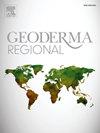Content and quality of soil organic matter in topsoils under different tundra vegetation in central Spitsbergen (High Arctic)
IF 3.1
2区 农林科学
Q2 SOIL SCIENCE
引用次数: 0
Abstract
Permafrost-affected soils contain a large amount of soil organic matter (SOM) which may become easily available to microbial decomposition due to climate warming. Despite numerous studies conducted on SOM in permafrost-affected soils, our knowledge about its quantity and chemistry requires further enhancement in the central part of Spitsbergen, due to a lack of detailed studies in this area. Especially, very little is known about the link between soil and vegetation in the High Arctic region. The main aim of this study was to determine the quantity and chemistry of SOM in the topsoil horizons of permafrost-affected soils covered with different tundra vegetation types in the vicinity of Longyearbyen (central Spitsbergen). Four types of tundra (pioneer tundra, arctic meadow, wet moss tundra, and heath tundra) were selected for this study. The obtained results indicate that the highest mean content of total organic carbon (TOC, 24.22 %) and total nitrogen (TN, 0.79 %) occurred in topsoils covered with heath tundra, while clearly lower mean contents of TOC and TN were noted in topsoils under wet moss tundra (5.96 %, 0.37 %, respectively), arctic meadow (3.40 %, 0.19 %, respectively), and pioneer vegetation (2.56 %, 0.21 %, respectively). The obtained FTIR-ATR spectroscopy results indicated significant differences in the chemical composition of SOM under different types of tundra. The highest mean value of the aromatic C/aliphatic C ratio (1632/2928 ratio) was noted for topsoils covered with arctic meadow (2.82). On the other hand, the lowest mean value of aromatic C/aliphatic C ratio for SOM was obtained for topsoils covered with heath tundra (0.81). This indicated that SOM in topsoils under heath tundra vegetation is characterized by a higher content of aliphatic compounds in relation to aromatic compounds. Moreover, both soil texture and soil pH significantly affected the content and quality of SOM in the studied topsoils.
斯匹次卑尔根中部(高纬度北极地区)不同苔原植被下表层土壤有机质的含量和质量
受永久冻土影响的土壤含有大量土壤有机质(SOM),由于气候变暖,这些有机质很容易被微生物分解。尽管对受永久冻土影响的土壤中的有机质进行了大量研究,但由于缺乏对斯匹次卑尔根中部地区的详细研究,我们对该地区土壤有机质的数量和化学性质的了解还需要进一步加强。尤其是对北极高纬度地区土壤与植被之间的联系知之甚少。这项研究的主要目的是确定在朗伊尔城(斯匹次卑尔根中部)附近不同冻土植被类型覆盖的受永久冻土影响的土壤表土层中 SOM 的数量和化学性质。这项研究选择了四种类型的苔原(先锋苔原、北极草甸、湿苔藓苔原和石楠苔原)。研究结果表明,被石楠苔原覆盖的表层土壤中总有机碳(TOC,24.22 %)和总氮(TN,0.79 %)的平均含量最高,而湿苔藓苔原(分别为 5.96 % 和 0.37 %)、北极草甸(分别为 3.40 % 和 0.19 %)和先锋植被(分别为 2.56 % 和 0.21 %)下的表层土壤中总有机碳和总氮的平均含量明显较低。傅立叶变换红外-原子吸收光谱分析结果表明,不同类型苔原下 SOM 的化学成分存在显著差异。芳香族碳/脂肪族碳比率(1632/2928 比率)的平均值在北极草甸覆盖的表层土壤中最高(2.82)。另一方面,覆盖有石楠苔原的表层土壤中 SOM 的芳香族 C/ 脂肪族 C 比率平均值最低(0.81)。这表明石楠苔原植被下表层土壤中的 SOM 具有脂肪族化合物含量高于芳香族化合物的特点。此外,土壤质地和土壤酸碱度对所研究表层土中 SOM 的含量和质量也有很大影响。
本文章由计算机程序翻译,如有差异,请以英文原文为准。
求助全文
约1分钟内获得全文
求助全文
来源期刊

Geoderma Regional
Agricultural and Biological Sciences-Soil Science
CiteScore
6.10
自引率
7.30%
发文量
122
审稿时长
76 days
期刊介绍:
Global issues require studies and solutions on national and regional levels. Geoderma Regional focuses on studies that increase understanding and advance our scientific knowledge of soils in all regions of the world. The journal embraces every aspect of soil science and welcomes reviews of regional progress.
 求助内容:
求助内容: 应助结果提醒方式:
应助结果提醒方式:


